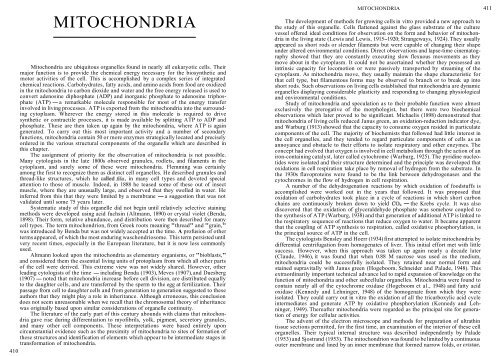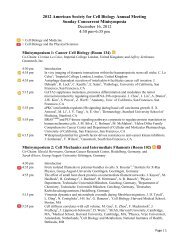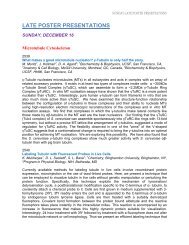Chapter 7: Mitochondria
Chapter 7: Mitochondria
Chapter 7: Mitochondria
Create successful ePaper yourself
Turn your PDF publications into a flip-book with our unique Google optimized e-Paper software.
MITOCHONDRIA<br />
<strong>Mitochondria</strong> are ubiquitous organelles found in nearly all eukaryotic cells. Their<br />
major function is to provide the chemical energy necessary for the biosynthetic and<br />
motor activities of the cell. This is accomplished by a complex series of integrated<br />
chemical reactions. Carbohydrates, fatty acids, and amino acids from food are oxidized<br />
in the mitochondria to carbon dioxide and water and the free energy released is used to<br />
convert adenosine diphosphate (ADP) and inorganic phosphate to adenosine triphos-<br />
phate (ATP) - a remarkable molecule responsible for most of the energy transfer<br />
involved in living processes. ATP is exported from the mitochondria into the surround-<br />
ing cytoplasm. Wherever the energy stored in this molecule is required to drive<br />
synthetic or contractile processes, it is made available by splitting ATP to ADP and<br />
phosphate. These are then taken up again by the mitochondria, where ATP is again<br />
generated. To carry out this most important activity and a number of secondary<br />
functions, mitochondria contain 50 or more enzymes strategically located and precisely<br />
ordered in the various structural components of the organelle which are described in<br />
this chapter.<br />
The assignment of priority for the observation of mitochondria is not possible.<br />
Many cytologists in the late 1800s observed granules, rodlets, and filaments in the<br />
cytoplasm, and surely some of these were mitochondria. Flemming was certainly<br />
among the first to recognize them as distinct cell organelles. He described granules and<br />
thread-like structures, which he calledfila, in many cell types and devoted special<br />
attention to those of muscle. Indeed, in 1888 he teased some of these out of insect<br />
muscle, where they are unusually large, and observed that they swelled in water. He<br />
inferred from this that they were limited by a membrane - a suggestion that was not<br />
validated until some 75 years later.<br />
Systematic study of this organelle did not begin until relatively selective staining<br />
methods were developed using acid fuchsin (Altmann, 1890) or crystal violet (Benda,<br />
1898). Their form, relative abundance, and distribution were then described for many<br />
cell types. The term mitochondrion, from Greek roots meaning "thread" and "grain,"<br />
was introduced by Benda but was not widely accepted at the time. A profusion of other<br />
terms appeared, of which the most enduring waschondriosome. This term persisted until<br />
very recent times, especially in the European literature, but it is now less commonly<br />
used.<br />
Altmann looked upon the mitochondria as elementary organisms, or "bioblasts,"<br />
and considered them the essential living units of protoplasm from which all other parts<br />
of the cell were derived. This extreme view was not widely shared. However, other<br />
leading cytologists of the time - including Benda (1903), Meves (1907), and Duesberg<br />
(1907) - noted that mitochondria increase before cell division, are distributed equally<br />
to the daughter cells, and are transferred by the sperm to the egg at fertilization. Their<br />
passage from cell to daughter cells and from generation to generation suggested to these<br />
authors that they might play a role in inheritance. Although erroneous, this conclusion<br />
does not seem unreasonable when we recall that the chromosomal theory of inheritance<br />
was originally based upon similar considerations of organelle continuity.<br />
The literature of the early part of this century abounds with claims that mitochon-<br />
dria gave rise during differentiation to myofibrils, yolk, pigment, secretory granules,<br />
and many other cell components. These interpretations were based entirely upon<br />
circumstantial evidence such as the proximity of mitochondria to sites of formation of<br />
these structures and identification of elements which appear to be intermediate stages in<br />
transformation of mitochondria.<br />
410<br />
MITOCHONDRIA 411<br />
The development of methods for growing cells in vitro provided a new approach to<br />
the study of this organelle. Cells flattened against the glass substrate of the culture<br />
vessel offered ideal conditions for observation on the form and behavior of mitochon-<br />
dria in the living state (Lewis and Lewis, 1915-1920; Strangeways, 1924). They usually<br />
appeared as short rods or slender filaments but were capable of changing their shape<br />
under altered environmental conditions. Direct observations and lapse-time cinematog-<br />
raphy showed that they are constantly executing slow flexuous movements as they<br />
move about in the cytoplasm. It could not be ascertained whether they possessed an<br />
intrinsic capacity for locomotion or were passively transported by streaming of the<br />
cytoplasm. As mitochondria move, they usually maintain the shape characteristic for<br />
that cell type, but filamentous forms may be observed to branch or to break up into<br />
short rods. Such observations on living cells established that mitochondria are dynamic<br />
organelles displaying considerable plasticity and responding to changing physiological<br />
and environmental conditions.<br />
Study of mitochondria and speculation as to their probable function were almost<br />
exclusively the prerogative of the morphologist, but there were two biochemical<br />
observations which later proved to be significant. Michaelis (1898) demonstrated that<br />
mitochondria of living cells reduced Janus green, an oxidation-reduction indicator dye,<br />
and Warburg (1913) showed that the capacity to consume oxygen resided in particulate<br />
components of the cell. The majority of biochemists that followed had little interest in<br />
the cell organelles, and they tended to regard particulate components of cells as an<br />
annoyance and obstacle to their efforts to isolate respiratory and other enzymes. The<br />
concept had evolved that oxygen is involved in cell metabolism through the action of an<br />
iron-containing catalyst, later called cytochrome (Warburg, 1925). The pyridine nucleo-<br />
tides were isolated and their structure determined and the principle was developed that<br />
oxidations in cell respiration take place by removal of hydrogen from the substrate. In<br />
the 1930s flavoproteins were found to be the link between dehydrogenases and the<br />
cytochromes in the flow of hydrogen in cell respiration.<br />
A number of the dehydrogenation reactions by which oxidation of foodstuffs is<br />
accomplished were worked out in the years that followed. It was proposed that<br />
oxidation of carbohydrates took place in a cycle of reactions in which short carbon<br />
chains are continuously broken down to yield COz - the Krebs cycle. It was also<br />
discovered that the oxidation of glyceraldehyde phosphate was somehow coupled to<br />
the synthesis of ATP (Warburg, 1938) and that generation of additional ATP is linked to<br />
the respiratory sequence of reactions that reduce oxygen to water. It became apparent<br />
that the coupling of ATP synthesis to respiration, called oxidative phosphorylation, is<br />
the principal source of ATP in the cell.<br />
The cytologists Bensley and Hoerr (1934) first attempted to isolate mitochondria by<br />
differential centrifugation from homogenates of liver. This initial effort met with little<br />
success. However, when this approach was taken up again nearly a decade later<br />
(Claude, 1946), it was found that when 0.88 M sucrose was used as the medium,<br />
mitochondria could be successfully isolated. They retained near normal form and<br />
stained supravitally with Janus green (Hogeboom, Schneider and Palade, 1948). This<br />
extraordinarily important technical advance led to rapid expansion of knowledge on the<br />
function of mitochondria and other subcellular organelles. <strong>Mitochondria</strong> were found to<br />
contain nearly all of the cytochrome oxidase (Hogeboom et al., 1948) and fatty acid<br />
oxidase (Kennedy and Lehninger, 1948) of the homogenate from which they were<br />
isolated. They could carry out in vitro the oxidation of all the tricarboxylic acid cycle<br />
intermediates and generate ATP by oxidative phosphorylation (Kennedy and Leh-<br />
ninger, 1949). Thereafter mitochondria were regarded as the principal site for genera-<br />
tion of energy for cellular activities.<br />
The advent of the electron microscope and methods for preparation of ultrathin<br />
tissue sections permitted, for the first time, an examination of the interior of these cell<br />
organelles. Their typical internal structure was described independently by Palade<br />
(1 953) and Sjostrand (1953). The mitochondrion was found to be limited by a continuous<br />
outer membrane and lined by an inner membrane that formed narrow folds, or cristae,




